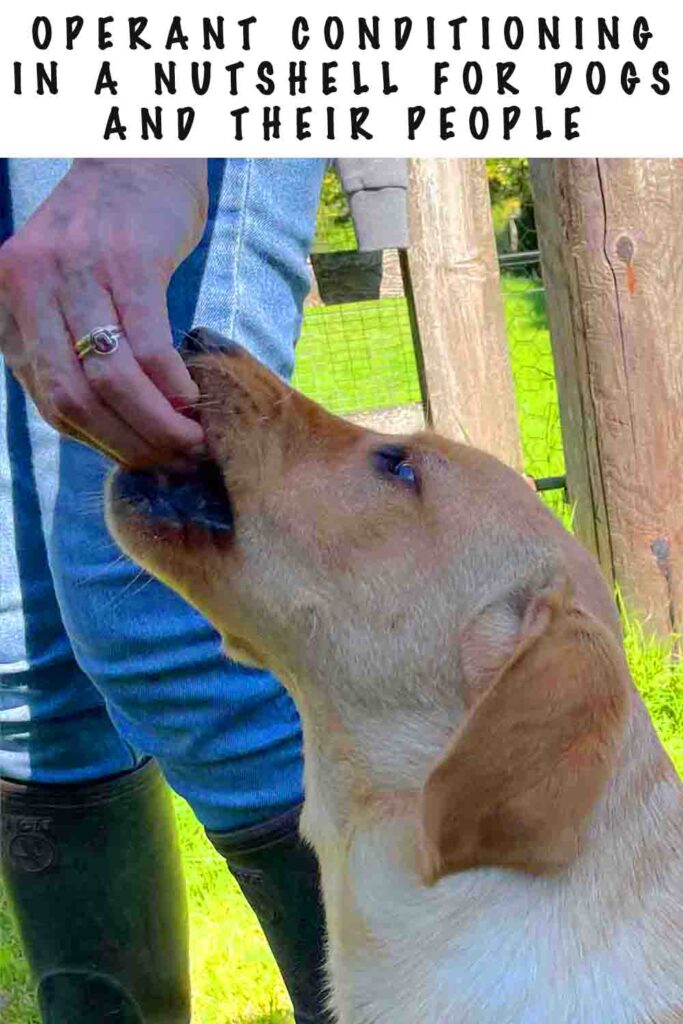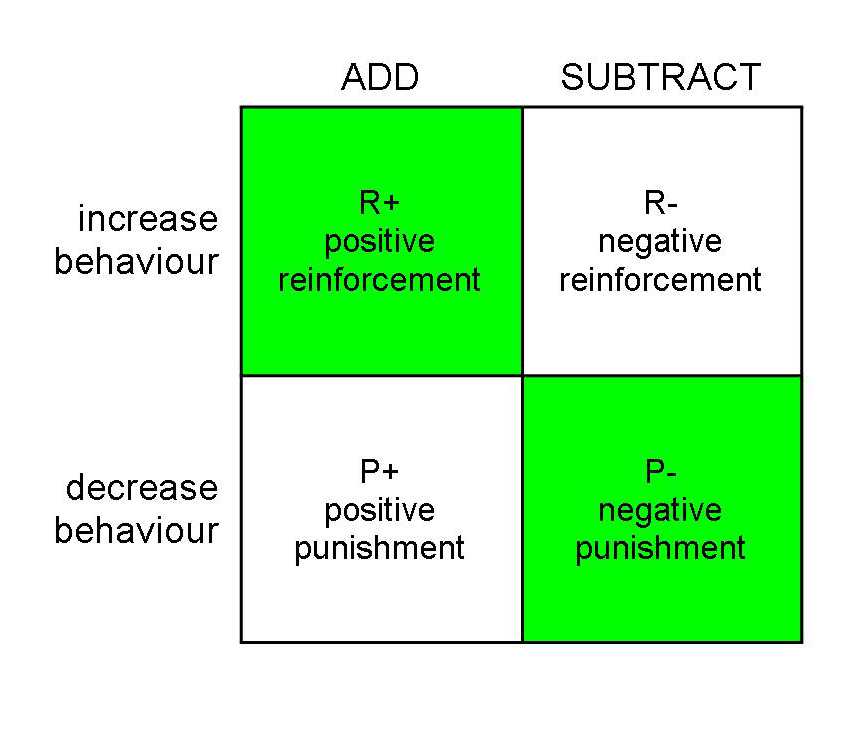
Operant conditioning is the process by which animals, including dogs, learn to change and modify their behavior.
There is quite a bit of confusion about this process in dog owning circles. And in particular about the use of two particular words
- Punishment
- Positive
We’ll go into that in a minute and hopefully all will become clearer!
Many traditional trainers view positive reinforcement training, and the operant conditioning it is based on, as a ‘fashion’ or ‘fad’ in dog training.
They see operant conditioning as something you can ‘choose’ to use, or leave to one side.
It is inescapable!
In fact, operant conditioning is a process that occurs all the time. Whether we are aware of it, actively use it, or desperately try to avoid it! It is inescapable. It even takes place when you are not there.
The term ‘operant conditioning’ refers to a ‘law’ or ‘rule’.
It simply describes the process through which animals modify the way they behave tomorrow, in response to the outcome of that behavior today.
In the same way the law of gravity might describe what is happening when you drop an apple.
What is great about operant conditioning, is that if you understand it, you can control it. At least, some of the time. And with regard to your dogs.
It isn’t the last word in dog training, but it is something we can all benefit from understanding.
A scientifically proven learning process
Operant conditioning is a well-studied process.
The principles of operant conditioning have been known and understood for many years now and if correctly applied can produce reliable, repeatable results in training a wide variety of species including ourselves!
Operant conditioning explains how the immediate consequences of an animal’s behavior have the power to alter that behavior in the future.
This enables an animal to learn from and make use of, the natural environment in which it lives.
The process is described in scientific terms and the terminology used can be confusing to begin with.
Words like punishment and positive, have a different meaning from that with which we are familiar. All is explained below.
Misunderstandings about punishment
Nothing makes traditional dog trainers more annoyed than to be told that they are punishing their dog. Especially when they didn’t even lay a finger on them!
Whenever there are misunderstandings and disagreements about positive or force free dog training, you can be pretty sure that the word ‘punishment’ features in there somewhere.
In layman’s language, punishment can mean all kinds of things. And no two people will ever agree on what defines a punishment, though most think it involves hurting a dog.
Because the word punishment has so many meanings it is helpful if we dog trainers stick to the true meaning of the word punishment, as a behavioral term.
The true meaning of punishment
The true meaning of punishment is beautifully clear, observable, and measurable. Which makes it a really useful word.
Anything which makes a behavior less likely to occur in the future, is defined as a ‘punisher’ and the application of that punisher is defined as a punishment.
The punishment does not have to be painful or violent, or harsh at all, for it’s application to be defined as a punishment.
All that is required is that it makes the behavior accompanying it less likely to re-occur. This means that the animal receiving the punishment must find it aversive. Understanding this is important both with animals and people.
The dog decides
A punishment is not defined by how harshly the provider of the punishment regards it, but by whether or not the subject (in this case a dog) we are imposing it on finds it aversive and to what degree.
What is a ‘punishment’ for one dog, may not be a ‘punishment’ for another. Nor is a punishment defined by the intention of the person supplying it.
Letting a firework off may not be intended to be a ‘punishment’ by your neighbour, but if it frightens your puppy whilst he picking up a ball for example, strictly speaking the puppy has been punished for grabbing the ball and he will be less likely to repeat the behavior in the future.
It isn’t about cruelty
When we refer to punishment in the context of training, it is this definition which we are using.
Some people that punish dogs are of course cruel. But most people that use punishment today are not. They may not be positive-only trainers, but they are not intending to cause, or succeeding in causing, physical or emotional harm to the dog.
And when a modern dog trainer, tells a traditional dog trainer that he is using punishment, this is in no way an accusation of cruelty. It is simply an observation that the trainer is applying a consequence which will diminish that particular behavior.
It is important that we are able to make this distinction, because increasing numbers of pet owners are now training their dogs without using aversives at all, and more are joining them all the time.
This is an exciting movement and it is achieving some great results already.

Reinforcement
Reinforcement is the other side of the coin.
Anything which makes a behavior more likely to occur in the future, is defined as a reinforcer, and the application of the reinforcer is defined as ‘reinforcement’.
This is not the same way in which many trainers use the word reinforcement when it is often used simply to mean ‘going over’ training until it is thoroughly understood.
I have become involved in some very muddled conversations talking to dog trainers who talk about ‘reinforcing’ their dog’s learning when they actually mean repeating exercises or drills until the dog ‘gets it’.
The dog still decides
Reinforcement, like punishment is defined by the dog, and by its effects, not by what the handler thinks ought to be reinforcing. So, if your dog doesn’t find having his ears rubbed reinforcing, it won’t improve the chances of him repeating the sit you just asked for.
Getting your head around this is a big advantage for any dog trainer who wants to train more humanely, as effective reinforcers make learning a breeze, and ineffective reinforcers inevitably lead to punishment.
This is because ineffective reinforcers don’t reinforce anything, and therefore don’t give the handler any control over the dog’s behavior
Types of reinforcement
In layman’s language, we often describe reinforcers as ‘rewards’ . A reinforcer can be anything the dog finds pleasurable, it does not need to be food, it can be toys, games, a retrieve and so on.
We are very fortunate in that many of the activities we can enjoy with dogs, such as tracking and retrieving, are intrinsically rewarding thus continually reinforcing their behavior without us having to constantly think of ways to do it artificially.
However, in the early stages of training, it helps if we can be inventive about ways to provide rewards, because it has now been shown beyond doubt, that some of the consequences we thought were rewarding to our dogs (like verbal praise) are actually not rewarding at all and don’t reinforce the dog’s behavior.
If you want to delve a bit further into operant conditioning, we can look at reinforcement and punishment in a bit more detail. Let’s look at how we use the words positive and negative in dog training
Let’s get positive
You’ve probably heard of Positive Reinforcement – which is what force free trainers use to create and maintain behaviors in their dogs.
This is another huge source of confusion.
Some traditional dog trainers refer to themselves as ‘positive’ trainers, because they are kind to their dogs, use plenty of rewards, and work with their dogs in an upbeat and positive way.
Unfortunately, this is not what positive means in dog training. And like the layman’s use of the word punishment, it isn’t a very helpful one, because positive used in this way means different things to different people.
There is much less confusion all around, if we use the behavioral meaning of the world positive.
Adding and taking away
The key is to remember that this ‘language’ was designed by scientists, and when they talk about positive and negative they are talking in the mathematical sense of adding or subtracting. Not about feeling great or grumpy!
There are two distinct ways in which to create both punishers and reinforcers. These are described by the words ‘positive’ and ‘negative’
Let’s add something!
Positive reinforcement is where something that the dog find pleasant, has been added to his environment. Like a catch of a ball, or a piece of chicken.
Positive punishment is where something (which the dog finds aversive) has been added to the dog’s environment whether it be a gesture, a word, a glance, or a slap.
In correct training terminology, these are all punishments. It takes a while to get used to this linking of the words punishment and positive. Especially if you are still thinking of the word positive as meaning cheerful or happy.
But don’t worry, if you keep on using the correct terms they will soon seem normal and you’ll wonder why you ever thought them strange.
Let’s take something away!
A negative punishment is where something pleasant to the dog has been subtracted or ‘taken away’. Usually by preventing the dog from having access to it, for example, using a long line to remove the opportunity to chase.
Force free trainers use negative punishment in this way.
A negative reinforcement is where something unpleasant has been taken away. Negative reinforcement is rarely used in UK dog training but is common in the US and forms the basis of the ‘force-fetch’ programme widely used in American retriever training.
Negative reinforcement is controversial because in order to remove the unpleasant stimulus (pain for example) the handler must first apply the unpleasant stimulus to the dog. Usually in the form of an ear pinch or toe hitch.
The Learning Quadrant
You can see now that with the option for both positive and negative punishers and reinforcers, we have four different types of consequence to apply to a dog’s behavior.
There are often described as the learning quadrant which you can see in the illustration. The ‘positive-only’ trainer uses only half of the learning quadrant – the green squares, plus a phenomenon known as ‘extinction’

What is extinction
Extinction is vitally important to clicker trainers. It is a process that describes the complete disappearance of a behavior. The process has been thoroughly proven and tested.
Extinction occurs reliably when an animal is neither rewarded nor punished for a particular behavior. In other words if nothing changes, if there is no consequence to a behavior, that behavior will die out.
Many traditional dog trainers find it laughable to assume that if you ignore an unwanted behavior it will disappear, they have seen for themselves that unwanted behaviors get worse. However, this is not because extinction does not exist, but because many unwanted behaviors DO have consequences. They are inherently self rewarding.
Extinction is a very difficult phenomenon to make use of outdoors and off leash, because of the environmental factors that the handler cannot control. Nevertheless, extinction is a real process and can be useful in an environment where the dog’s handler has complete control – in the home for example or in a confined pen.
Three outcomes
In simple terms there are three possible outcomes to any action that your dog carries out
- Things get better for the dog
- Things get worse for the dog
- Things stay the same for the dog
If the first outcome occurs that dog will be more likely to repeat the behavior in the future. If the second or third outcome occurs he will be less likely to do so.
There will be one of these outcomes or consequences to any behavior exhibited by your dog. Whether or not you are there. If you want to control the way your dog behaves in the future, you will need to take control of the consequences of his behavior in the present.
This can be quite challenging at times!
If you found explanation of operant conditioning helpful you might also like to read ‘classical conditioning in a nutshell for dog trainers‘
Learning the lingo
Learning the language of dog training is vital if dog trainers are to move with the times. The language of behavioral science has become the international language of dog trainers.
It is recognised and understood all over the world, and it is important that skilled and caring dog trainers that have much to offer their students, do not get left behind.

Free Training Tips
Get Pippa's free dog training tips delivered to your inbox

 The Pros And Cons Of Feeding Your Dog Once A Day
The Pros And Cons Of Feeding Your Dog Once A Day